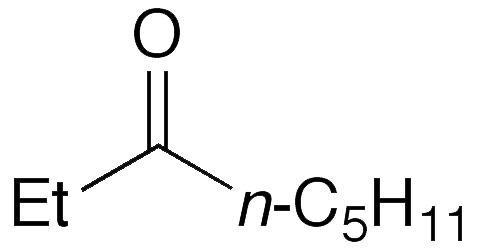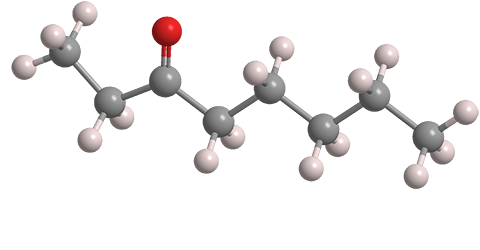What molecule am I?


3-Octanone, known to old-timers as n-amyl ethyl ketone, is a fragrant liquid produced by plants as diverse as lavender (Lavandula angustifolia), rosemary (Salvia rosmarinus), and nectarines (Prunus persica var. nucipersica). Its olfactory properties make it a useful flavor and fragrance agent.
But 3-octanone has a malicious side. A widely cultivated and consumed mushroom, Pleurotus ostreatus, produces the ketone to combat nematode (Caenorhabditis elegans) invasions. This distinct strategy kills the microscopic worms by disrupting their cell membranes and then uses them as nutrients.
In January this year, Yen-Ping Hsueh and several colleagues at Academica Sinica (Taipei, Taiwan), National Taiwan University (Taipei), and other institutions in Taiwan and Japan demonstrated the mechanism that 3-octanone uses against the mushroom’s prey. When the researchers treated C. elegans directly with the ketone, it caused the same rapid paralysis, calcium influx, and neuronal cell death as does the carnivorous mushroom.
3-Octanone hazard information
| Hazard class* | GHS code and hazard statement | |
|---|---|---|
| Flammable liquids, category 3 | H226—Flammable liquid and vapor | |
| Skin corrosion/irritation, category 2 | H315—Causes skin irritation | |
| Serious eye damage/irritation, category 2A | H319—Causes serious eye irritation | |
*Globally Harmonized System (GHS) of Classification and Labeling of Chemicals. Explanation of pictograms.
MOTW updates
Fipronil1 was the Molecule of the Week for June 14, 2021. It is a broad-spectrum insecticide with several known environmental hazards, including contamination of chicken eggs in the Netherlands in 2017. Earlier this month, Weidong Qu and colleagues at Fudan University (Shanghai), the China National Center for Food Safety Risk Assessment (Beijing), Qingdao University (China), and Oxford University (UK) reported that fipronil and its metabolites in drinking water can produce thyroid-disrupting effects in humans.
Naloxone 2 (trade name Narcan) was the Molecule of the Week for May 23, 2016. It is an opiate antagonist first produced in the 1960s that is much in the news as a nasal-spray “rescue” drug for people who overdose on opioids. In late March, the US Food and Drug Administration approved naloxone for over-the-counter sales. Its manufacturer says that it should be available in stores and online by late summer.
1. CAS Reg. No. 120068-37-3.
2. CAS Reg. No. 465-65-6.
This molecule was suggested by a reader. We present almost all of the molecules suggested by our readers. If you have a molecule you would like us to consider, please send us a message. And thank you for your interest in Molecule of the Week! —Ed.
3-Octanone fast facts
| CAS Reg. No. | 106-68-3 |
| SciFinder nomenclature | 3-Octanone |
| Empirical formula | C8H16O |
| Molar mass | 128.21 g/mol |
| Appearance | Colorless, oily liquid |
| Boiling point | 168 °C |
| Water solubility | 2.6 g/L |

Learn more about this molecule from CAS, the most authoritative and comprehensive source for chemical information.
Molecule of the Week needs your suggestions!
If your favorite molecule is not in our archive, please send us a message. The molecule can be notable for its current or historical importance or for any quirky reason. Thank you!
Stay Ahead of the Chemistry Curve
Learn how ACS can help you stay ahead in the world of chemistry.

